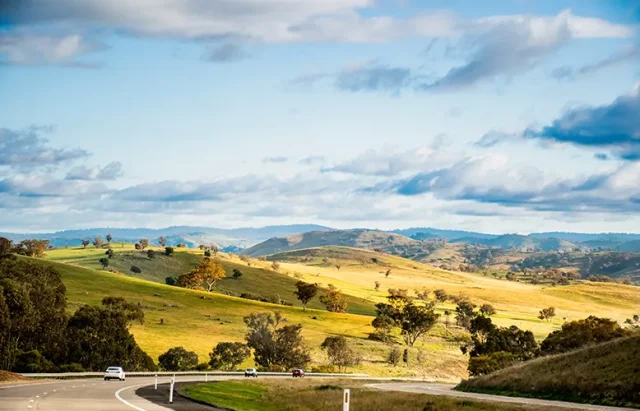
Australia offers a variety of landscapes and natural beauty, making it perfect for people who love photography. As more people enjoy exploring by road trips, this blog aims to create picture-perfect travel plans for those wanting to capture the country’s charm in lasting photos.
Choosing the Perfect Route
Choosing the best path is very important for a road trip that matches what the traveler likes to take pictures of. We will talk about why this choice matters and point out famous roads like the Great Ocean Road, Pacific Coast Highway, and Red Centre Way.
1. Alignment with Photography Preferences:
Selecting a path that matches the traveler’s liking for taking pictures makes the journey more satisfying. For example, if someone wants to take photos of sea views very much, then going on the Pacific Coast Highway is a perfect decision. Understanding personal interests helps in tailoring the journey for maximum photographic satisfaction.
2. Iconic Routes:
Famous paths such as the Great Ocean Road give many chances to take pictures. This way, known for its beautiful views of the coast and the shapes of rocks, has a variety of things for taking photos. The Pacific Coast Highway, which twists next to the sea, and Red Centre Way which goes straight through Australia’s center, display different but very interesting sceneries.
3. Consideration of Season, Time, and Weather Conditions:
- Seasonal Variations: Different paths show unique landscapes at different times of the year. For example, the Great Ocean Road has colorful leaves in fall and Red Centre Way shows amazing flowers in the desert when it rains.
- Time of Day: Understanding the way sunlight works with environments is very important. Light in the morning and evening usually makes soft, strong shadows that make photos look better. Planning stops during these times can significantly elevate the quality of images.
- Weather Conditions: Weather is very important for taking photos. Having no clouds in the sky can be good for taking pictures of big open places, but if it’s cloudy, it can make the picture look more dramatic. Yet, rain or fog can provide special chances for taking photos, especially in places like rainforests or near the sea.
When travelers think about these things, they can make a good plan for their trip. This helps them take the best pictures that fit what they like and show the special parts of the places they visit. Doing this makes their road trip better and also helps to tell a strong story with their photos. If you want to rent a car for your road trip, head to the Alphacarhire site, where you can find a range of options to make your journey through Australia even more convenient and enjoyable.
Strategic Stops for Photography
Going on a road trip is not only about the drive but also about getting the true feel of the selected path by planning stops well. We explore how to plan these stops to take better photos.
1. Explore Key Landmarks and Natural Wonders:
It is very important to recognize and visit important places and beautiful natural sights on the selected path. These might be famous locations, historical sites, or amazing scenery that represent the true spirit of travel. Each stop becomes an opportunity to tell a unique visual story.
2. Tips for Sunrise and Sunset Photography:
If you arrange your schedule to stop for photos when the sun is rising or setting, you can get very good light. The sunlight during these times has a gentle and warm colour that makes outdoor pictures look better. Placing strategic stops at the same time as these moments helps photographers take pictures of the changing beauty in light and shadows.
3. Researching Lesser-Known Yet Picturesque Spots:
Beyond the famous places, looking for and finding less known yet beautiful locations can result in very special photos. Information from the internet, advice from local people or travel books might help to discover secret spots on the way. These places allow taking pictures of the location from a new and more uncommon viewpoint.
4. Emphasizing Spontaneity and Openness to Detours:
Keeping yourself open to sudden changes and welcoming unpredicted paths is essential for finding those secret treasures. Chance meetings and stops that you did not plan might bring about unexpected chances for taking photos. Having a flexible plan when traveling lets people enjoy the present and find genuine experiences away from the usual tourist routes.
By making a plan for stops with careful thought, including pictures of the sunrise and sunset, looking into places that are not well-known, and being open to unplanned experiences, lovers of road trips can make a collection of photographs that tell deeper stories about their travels. Every stop adds an important part to the story told by the pictures from their adventure on the road.
Gear and Photography Techniques
When you plan a driving journey across Australia, think well about the camera equipment and methods so that you can take excellent pictures of different sceneries, animals, and cultural features. This is advice to help improve your photo-taking adventure:
Essential Photography Gear:
- Versatile Camera: Invest in a good camera that is adaptable and fits your taste and experience in photography. Both mirrorless cameras and DSLRs provide great picture quality with many options for use.
- Zoom Lens: A zoom lens that has a big range of focal lengths is very important for taking pictures of large sceneries and far away objects. It helps you not have to switch lenses often, especially when there’s not much room or it’s too heavy.
- Sturdy Tripod: A strong tripod that is also small can be very useful for taking pictures with long exposure times, particularly when there isn’t much light. It’s good to choose one that is not heavy but still keeps the camera steady.
- Polarizing Filter: Use a polarizing filter to make colors more vibrant and decrease shine, especially good for outdoor views or places with shiny things.
- Drone: If you want to take different views from the sky of Australia’s big lands, think about using a drone. Make sure you follow the area’s rules and handle it in a way that shows consideration for people’s private space and nature.
- Camera Bag: Choose a travel-designed camera bag that allows quick reaching for your gear while it stays safe and guarded.
Photography Techniques:
Landscape Photography:
- Use a wide-angle lens to capture the breadth of landscapes.
- Frame shots with a foreground element to add depth and interest.
- Experiment with different compositions, including leading lines and the rule of thirds.
Wildlife Photography:
- Approach wildlife with caution, maintaining a respectful distance.
- Use a telephoto lens to capture detailed shots without disturbing the subjects.
- Be patient and observe animal behavior for natural and candid shots.
Cultural Photography:
- Engage with locals to capture authentic cultural moments.
- Use a prime lens for portraits, capturing facial expressions and details.
- Pay attention to composition, incorporating cultural elements into your frame.
Camera Settings for Varying Lighting Conditions:
Daylight:
- Use a lower ISO setting for optimal image quality.
- Adjust the aperture for the desired depth of field.
- Experiment with shutter speed to control motion.
Low Light:
- Increase ISO to maintain exposure in low-light conditions.
- Use a wider aperture for more light.
- Consider using a tripod to stabilize longer exposures.
Backlit Scenes:
- Use exposure compensation to balance the exposure.
- Focus on the main subject to ensure proper lighting.
- Experiment with fill flash to reduce harsh shadows.
Drone Photography:
- Comply with local regulations and respect no-fly zones.
- Plan flights during optimal lighting conditions.
- Experiment with different altitudes and angles for diverse perspectives.
- Focus on capturing landscapes, avoiding intrusive shots of private spaces.
Conclusion:
Making a road trip plan that matches with the love for taking pictures is more than just an idea; it’s a key rule to make memories that stay forever. The travel turns into a picture tale, each photo holding onto a point in time, showing Australia’s charm from different views.
Choose proper equipment, learn photo skills well, change camera options and use drone pictures carefully to make your Australia journey look amazing with different kinds of photos.





